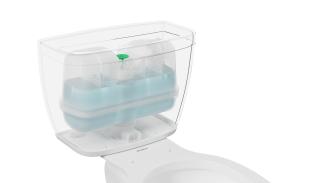
Long before pressure-assisted fixtures are installed into restroom environments, they undergo a series of comprehensive tests to ensure they deliver all the water-saving and drainline carry benefits that the industry has come to expect from pressure-assist systems.
But at Flushmate, those tests are just the baseline to ensure its products continue to deliver best-in-class benefits, even while flush volumes continue to drop.
We sat down with Jasris Jasnie, Director of Engineering at Flushmate, to learn more about Flushmate’s proprietary in-house testing for everything from flow rate and drainline carry testing to performance evaluation and sound testing.
How does Flushmate’s internal testing process help ensure enhanced performance?
Our internal testing process at Flushmate is designed to ensure that every product we produce meets our highest standards of performance, durability, efficiency, and reliability. We operate on a foundation of rigorous testing and cutting-edge research and development (R&D), leveraging decades of engineering expertise to continually improve our products. The Flushmate system must meet stringent structural integrity requirements, including fatigue and creep resistance, as well as flow and sound performance. They are evaluated via virtual testing and physical testing methods.
Virtual testing employs advanced finite element analysis (FEA) software to evaluate structural and noise performance, and advanced computational fluid dynamics (CFD) software to analyze flow performance. Testing virtually enables us to rapidly assess a large number of design solutions within a condensed timeframe.
Once the best solution is found via virtual testing, we proceed to physical testing using rapid prototypes fabricated via high-speed 3D printing. Our system then goes through comprehensive testing at our ISO17025 certified lab per ASME A112.19.2* as well as our own rigorous internal test protocols.
*Standard for ceramic plumbing fixtures in North America
How does Flushmate’s testing address the wear and tear of daily use over time?
We use several methods to ensure our system is robust and can withstand the rigor of daily use:
1. Accelerated lifecycle testing: This involves simulating years of use in a short amount of time by evaluating the creep and fatigue resistance simultaneously. This helps us quickly identify and address potential issues.
2. Thermal aging: Our system is subjected to elevated temperatures to accelerate wear and identify how they will perform over time. This ensures they remain reliable even under extreme conditions.
3. Chemical resistance: By immersing or exposing our system to a variety of chemicals, we assess their resistance to corrosion, swelling, and other forms of chemical degradation. Doing so allows us to ensure that our products continue to function as expected over time.
These comprehensive testing methodologies ensure that every part of the Flushmate system meets our durability requirements. Through accelerated testing, we are able to verify that our products deliver long-term reliability for our customers in demanding real-world applications.
Can you explain how drainline carry is assessed?
Drainline carry is an important performance measure for toilet systems, defined by the ASME A112.19.2 standard. It refers to the distance waste travels through the drainline after a flush, ensuring proper removal and reducing the risk of clogs. The minimum requirement per the standard is 40ft.
To assess drainline carry, rigorous testing is conducted under controlled conditions in our ISO17025 certified labs designed specifically for this purpose. At Flushmate, we evaluate the performance of both gravity and pressure-assisted toilets. In these tests, we use synthetic waste to simulate real-world conditions. The testing process measures how far waste is carried through the drainline, with controlled variables like pipe diameter, slope, and flush volume to ensure consistent results. The key is to find the right balance between water efficiency and effective waste transport, ensuring reliable performance without excessive water use.
What is Flushmate’s sound evaluation process?
Sound testing is an important part of how we evaluate the user experience for toilets, and we do this in reverberant chambers designed to mimic real restroom environments. These chambers help us measure the noise levels during a flush, giving us insights into how sound behaves in a space similar to a typical bathroom. We used an industrial grade sound measurement device typically used in the automotive and aerospace industries to measure and analyze sound pressure and loudness.
At Flushmate, we’ve been working hard over the years to soften the sound coming from the pressure-assisted bowl. Over the last few decades, we have been able to reduce the overall peak sound volume, and I’m proud to say our new 503UH 0.75 gpf model is the quietest we’ve ever produced. We’ve balanced the sound over the full flush cycle while reducing the flush volume and keeping the performance level our customers have come to expect.